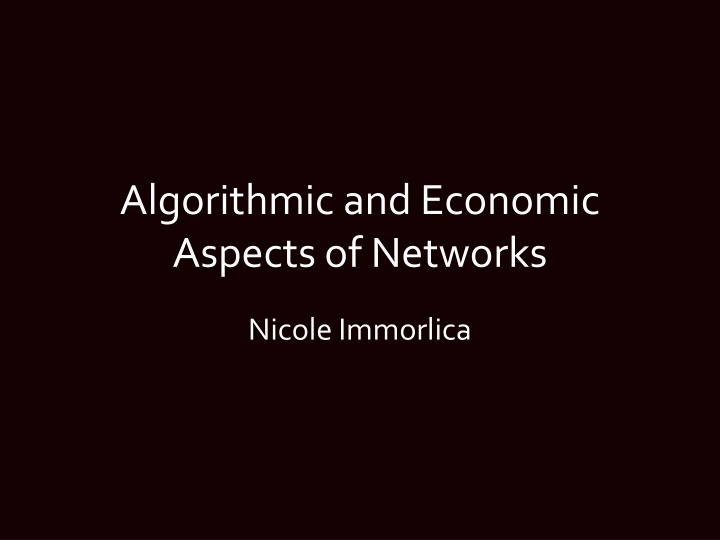
Algorithmic and Economic Aspects of Network Graphs and Percolation Theory
Explore the intersection of algorithmic and economic aspects in network graphs along with insights into random graphs, Erdos-Renyi models, percolation theory, and critical thresholds. Discover the properties and behaviors of random graphs and percolation on binary trees through informative visuals and demonstrations.
Uploaded on | 1 Views
Download Presentation

Please find below an Image/Link to download the presentation.
The content on the website is provided AS IS for your information and personal use only. It may not be sold, licensed, or shared on other websites without obtaining consent from the author. If you encounter any issues during the download, it is possible that the publisher has removed the file from their server.
You are allowed to download the files provided on this website for personal or commercial use, subject to the condition that they are used lawfully. All files are the property of their respective owners.
The content on the website is provided AS IS for your information and personal use only. It may not be sold, licensed, or shared on other websites without obtaining consent from the author.
E N D
Presentation Transcript
Algorithmic and Economic Aspects of Networks Nicole Immorlica
Random Graphs What is a random graph?
Erdos-Renyi Random Graphs Specify number of vertices n edge probability p G(n,p) For each pair of vertices i < j, create edge (i,j) w/prob. p
Erdos-Renyi Random Graphs What does random graph G(n,p) look like? (as a function of p)
Random Graph Demo http://ccl.northwestern.edu/netlogo/models/GiantComponent
Properties of G(n,p) p < 1/n disconnected, small tree-like components p > 1/n a giant component emerges containing const. frac. of nodes
Proof Sketch 1. Percolation 2. Branching processes 3. Growing spanning trees
Percolation 1. 2. 3. Infinite graph Distinguished node i Probability p Each link gets ``open with probability p Q. What is size of component of i?
Percolation Demo http://ccl.northwestern.edu/netlogo/models/Percolation
Percolation on Binary Trees V = {0,1}* E = (x,y) s.t. y = x0 or y = x1 distinguished node 0 1 01 10 00 11 Def. Let (p) = Pr[comp( ) is infinite]. The critical threshold is pc = sup { p | (p) = 0}.
Critical Threshold Def. Let (p) = Pr[comp( ) is infinite]. The critical threshold is pc = sup { p | (p) = 0}. Thm. Critical threshold of binary trees is pc = . Prf. On board.
Critical Threshold (p) 1 0 1/k p Thm. Critical threshold of k-ary trees is pc = 1/k.
Branching Processes Node i has Xi children distributed as B(n,p): Pr[Xi = k] = (n choose k) pk (1-p)(n-k) Q. What is probability species goes extinct? A. By percolation, if p > (1+ )/n, live forever. Note extinction Exists i, X1+ + Xi < i.
Erdos-Renyi Random Graphs We will prove (on board) (1) If p = (1- )/n, then there exists c1 s.t. Pr[G(n,p) has comp > c1 log n] goes to zero (2) If p = (1+2 )/n, then there exists c2 s.t. Pr[G(n,p) has comp > c2 n] goes to one First show (on board) (3) If p = (1+2 )/n, then there exists c2, c3 s.t. Pr[G(n,p) has comp > c2 n] > c3
Emergence of Giant Component Theorem. Let np = c < 1. For G G(n, p), w.h.p. the size of the largest connected component is O(log n). Theorem. Let np = c > 1. For G G(n, p), w.h.p. G has a giant connected component of size ( + o(n))n for constant = c; w.h.p, the remaining components have size O(log n).
Application Suppose the world is connected by G(n,p) someone gets sick with a deadly disease all neighbors get infected unless immune a person is immune with probability q Q. How many people will die?
Analysis 1. Generate G(n,p) 2. Delete qn nodes uniformly at random 3. Identify component of initially infected individual
Analysis Equivalently, 1. Generate G((1-q)n, p) 2. Identify component of initially infected individual
Analysis By giant component threshold, p(1-q)n < 1 disease dies p(1-q)n > 1 we die E.g., if everyone has 50 friends on average, need prob. of immunity = 49/50 to survive!
Summary Random graphs G(n, c/n) for c > 1 have unique giant component small (logarithmic) diameter low clustering coefficient (= p) Bernoulli degree distribution A model that better mimics reality?
In real life Friends come and go over time.
Growing Random Graphs On the first day, God created m+1 nodes who were all friends And on the (m+i) th day, He created a new node (m+i) with m random friends
Mean Field Approximation Estimate distribution of random variables by distribution of expectations. E.g., degree dist. of growing random graph?
Degree Distribution Ft(d) = 1 exp[ -(d m)/m ] (on board) This is exponential, but social networks tend to look more like power-law deg. distributions
In real life The rich get richer much faster than the poor.
Preferential Attachment Start: m+1 nodes all connected Time t > m: a new node t with m friends distributed according to degree = m x deg(j) / deg(.) = m x deg(j) / (2mt) = deg(j) / (2t) Pr[link to j]
Degree Distribution Cumulative dist.: Ft(d) = 1 m2/d2 Density function: ft(d) = 2m2/d3 (heuristic analysis on board, for precise analysis, see Bollobas et al) A power-law!
Assignment: Readings: Social and Economic Networks, Chapters 4 & 5 M. Mitzenmacher. A brief history of generative models for power law and lognormal distributions. Internet Mathematics 1, No 2, 226-251, 2005. D.J. Watts, and S.H. Strogatz. Collective dynamics of small-world networks. Nature 393, 440-442, 1998. Reactions: Reaction paper to one of research papers, or a research paper of your choice Presentation volunteer?

